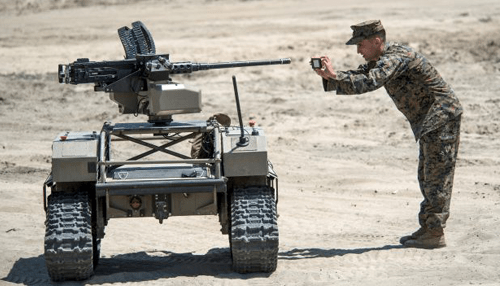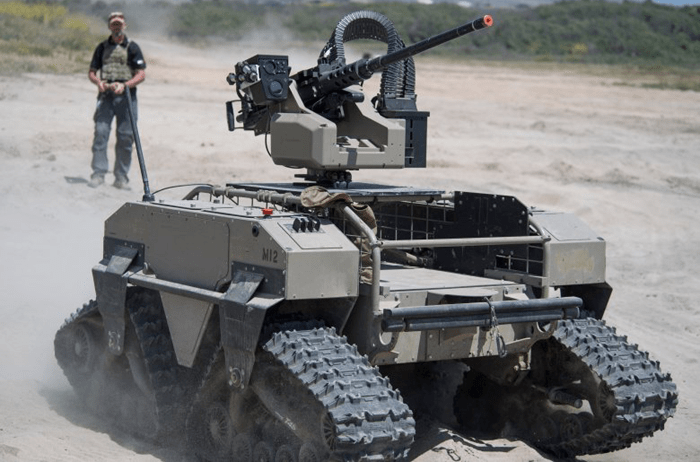Camp Pendleton Several large drones — one with a 9-foot wingspan — swooped over the surf and canyons and along with combat town at Red Beach. Below them, three Reconnaissance Marines on personal watercraft landed and surveyed the area in preparation for the main landing force.
Next, a wave of amphibious assault vehicles surrounded by more unmanned vehicles stormed ashore.
Marines, supported by unmanned fire-support vehicles and using hand-held tablets, jumped from the back of the assault vehicles and launched drones to strike targets and gather real-time, bird’s eye views of their surroundings.
Camp Pendleton
The exercise Wednesday at Camp Pendleton as part of the Advanced Technology Exercise 2017 — a collaborative technology expo held by Marine Corps Combat Development and the Integration Command and Naval Research Development, Test, and Evaluation Command.
The event showcased dozens of emerging technologies to give Marines and sailors the upper hand in fighting the next generation of wars.
The high-tech equipment is a complete shift from the last 16 years when Marines fought a completely different enemy in Iraq and Afghanistan. The fights there focused on counterinsurgency and finding improvised explosive devices.
Now it’s about surface-to-ship missiles and locating the enemy’s missiles on the coast.
“In the early 1990s we had guaranteed maritime supremacy; that’s no longer true,” said Marine Col. Daniel Sullivan, chief of staff for the Marine Corps Warfighting Laboratory. “Near peer competition (China and Russia) have closed the gap and now even primitive adversaries like ISIS can fly UAV’s with explosives charges on them.”
Vendors, contractors, and naval laboratories showed equipment being tested or already in use and demonstrated advanced applications to be used in the future. There were machine-gun-carrying robots, convertible submarines, and remote, self-propelled divers that could collect data underwater.
In the last week, Marines and sailors at Camp Pendleton have tested the futuristic equipment to see how well it would work in the war zone between a Navy ship dropping off Marines and their amphibious vehicles and their landing on the beach.
By soliciting ideas from academics and technology engineers, Marine commanders are getting options they might not generally have been exposed to through the traditional Department of Defense contractors. Here, the ideas came from technology not only made for war.
“If the first thing ashore in the next conflict is a Marine, we will fail,” said Brig. Gen. Julian Alford, vice chief of Naval Research and commander, Marine Corps Warfighting Lab. “A machine needs to be in there.”
Ed Hackett, Sr., a retired Marine F-18 test pilot who was based at El Toro and Miramar, demonstrated the Killswitch, an android tablet Marines can use when landing on the beach to see where the enemy is. The tablet, critical to Wednesday’s exercise, is being developed in a naval lab at China Lake.
Puma drone
It receives data from a Puma drone that flies 300 to 1,000 feet above the ground. Marines can carry it in their backpacks or use a smaller hand-held device.
Commanders on a Navy ship can use the tablet to review landing zones before a platoon of Marines gets into the water, Hackett said. Once on land, they can use it to link up with the drone in a specific location to view the area below.
The tablets are already being used by the 3rd Battalion/5th Marines, and this summer commanders will bring 1,100 hand-held size tablets on board.
Another piece of stealth technology featured during the beach assault was an unmanned surface vessel produced in collaboration with Maritime Tactical Systems in Florida and Booz/Allen Hamilton in California.
The vessel, made of carbon fiber and Kevlar, can be launched from a Navy ship 20 miles from the beach. It travels 60 miles per hour and can idle in one location indefinitely.
“It can come to the beach ahead of Marines and sailors and look for the enemy and send back information,” said Brad Pilsl, lead business development and technology developer for Booz/Allen Hamilton.
The vessel is currently being used by an energy company to inspect dams and bridges in Missouri.
Marine Corps officials point to the urgency of the Marine Corps and Navy to move quickly in acquiring the necessary technologies and to take advantage of tech-savvy Marines joining the Corps.
Cpl. Edmund Kennedy, 22, said using the new technology is easy. It also isn’t what he thought he’d be doing when he joined the Marine Corps four years ago.
“It’s like a video game,” he said. “It’s what we do in our free time and then brings these skills to work with us.”
Source: Ocregister



